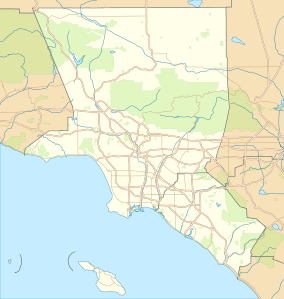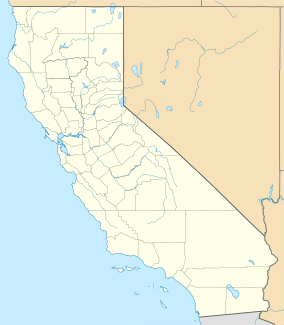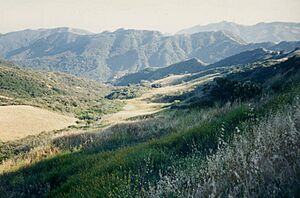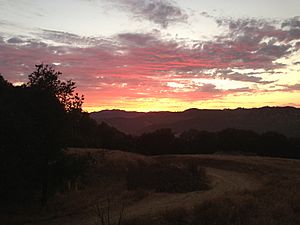Topanga State Park facts for kids
Quick facts for kids Topanga State Park |
|
|---|---|
|
IUCN Category III (Natural Monument)
|
|
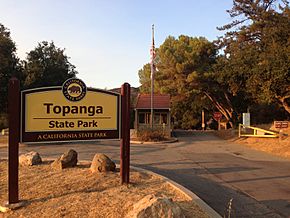
The entrance to the Trippet Ranch area of Topanga State Park
|
|
| Location | Los Angeles County, California, USA |
| Nearest city | Los Angeles, CA |
| Area | 11,000 acres (45 km2) |
| Established | 1964 |
| Governing body | CA Dept. of Parks & Recreation |
Topanga State Park is a special nature area in the Santa Monica Mountains in Los Angeles County, California. It's part of the larger Santa Monica Mountains National Recreation Area. This park was closed for a while starting April 7, 2020, because of the global health situation at that time.
The park is right next to the town of Topanga, inside the City of Los Angeles. It covers a huge area of 11,000 acres (about 45 square kilometers). That's like 8,300 football fields! It has 36 miles of trails and roads for exploring. You can find more than 60 different ways to enter the park. Topanga State Park is not only the biggest park in the Santa Monica Mountains, but it's also thought to be the largest park located within a city's limits.
Contents
Discovering Topanga State Park's Past
Who Lived Here First? Native Americans
The name "Topanga" comes from an old Shoshone language word. It means 'above', referring to how the canyon settlement was above the floodwaters of Topanga Creek. For thousands of years, the land of Topanga Canyon was home to Native American groups. These groups are known as the Topanga Culture, and they included the Tongva and Chumash peoples.
How Did Spanish and Mexican Rule Change Topanga?
In 1542, Juan Rodríguez Cabrillo claimed California for Spain. But the Topanga area wasn't settled by Europeans until the late 1700s. This was after the Pueblo de Los Angeles (which became the city of Los Angeles) and Mission San Fernando Rey de España were built. In 1821, Mexico became independent from Spain. This meant that Alta California, including Topanga, was now under Mexican rule.
In 1828, the Mexican Governor gave Francisco Sepulveda a temporary title to over 30,000 acres of land. This land was called Rancho San Vicente y Santa Monica. It included parts of the city of Santa Monica and the mountains near Topanga Creek. Most of this land was left wild. Only the flat parts were used for growing crops and grazing animals. The steep areas were too difficult to use.
When Did Americans Settle Topanga?
California became part of the United States in 1848 and a state in 1850. The ownership of the Rancho San Vicente y Santa Monica land was confirmed by the U.S. government. This made the land available under the Homestead Act. This act allowed people to claim land if they lived on it and improved it. One person who claimed land was a beekeeper named McAtee. His land was on the western edge of the rancho, near what is now the main entrance to Topanga State Park.
In the 1920s, Topanga Canyon became a popular spot for people from Los Angeles to visit on weekends. Many summer cabins were built along Topanga Creek. In 1917, Oscar A. Trippet, Sr. bought half of the McAtee homestead. His family used it as a getaway from the city. After Oscar Trippet Sr. passed away in 1923, his son, Oscar Jr., hired an architect to build a superintendent's house, horse stables, and a lodge for skeet shooting. A pond was also built, which you can still see in the park today near the parking lot. The Trippet family owned the land until 1963, when they sold it to a developer.
The next year, in 1964, voters approved a plan to buy Trippet Ranch and some land next to it. Topanga State Park officially opened to the public in 1974. The park now includes over 7,500 acres from the original Rancho San Vicente y Santa Monica. More land has been added over the years, including 1,500 acres from the Palisades Highlands and another 1,600 acres in 2002 near Topanga Creek.
Exploring Topanga's Natural World
What Rocks and Landforms Can You See?
Topanga State Park has many interesting rock formations. You can see layers of sandstone rock, which formed from sand over millions of years. There are also fossils of sea creatures, showing that this area was once under water! You can even spot exposed faults, which are cracks in the Earth's crust where rocks have moved. There are also signs of ancient volcanoes.
What Plants Grow in Topanga State Park?
The main types of plant areas in the park are Coastal sage scrub and montane chaparral and woodlands. These are common plant communities in California. At Trippet Ranch, there's a large area of California oak woodland, with many oak trees.
Smaller plant areas include bay laurel woodland and walnut woodland. You can also find grassland savannah areas. The park has so many different types of plants because of its many microclimates. These are small areas with slightly different weather conditions, like more shade or more moisture.
What Animals Live in Topanga State Park?
The park is home to over 80 different kinds of mammals. It also has more than 60 types of reptiles and amphibians. One snake you might see is the Southern Pacific rattlesnake. Topanga State Park is also a great place for birdwatching. Many different kinds of birds live here all year, and others visit during their migrations.
What is the Topanga Nature Center?
The Topanga Nature Center is a cool place to learn about the park's plants, animals, and geography. It has a collection of mounted native animals and birds, so you can see them up close. There are also hands-on displays with natural items. The Center is located in the old lodge that the Trippet Ranch used for skeet shooting. It's a short walk from the Trippet Ranch parking lot and is usually open on Sunday afternoons.
Fun Things to Do in Topanga State Park
What Are the Best Trails for Exploring?
Topanga State Park has many trails for hikers, mountain bikers, and horseback riders. You'll see signs telling you which trails are open for each activity. The main starting points for trails are at the Trippet Ranch area. From here, you can access the Musch Trail, which passes by the famous Eagle Rock. Many trails are also wide dirt roads, which are great for fire safety.
You can also reach unpaved parts of Mulholland Drive through the Temescal Fire Road. The Backbone Trail System is a very long trail, almost 70 miles, that goes through the Santa Monica Mountains. It passes right through Topanga State Park, and you can get on it from the Trippet Ranch trailhead.
The Santa Inez Trail is another popular path. You can start it from Trippet Ranch on the west or the Palisades Highlands neighborhood on the east. The lower part of the trail follows Santa Inez Creek through areas with lots of water-loving plants. Then, it climbs up through amazing sandstone formations to the Topanga Fire Road and Trippet Ranch.
How Topanga State Park Gets Its Funding
California Department of Parks and Recreation's Role
In 2008, the California Governor at the time, Arnold Schwarzenegger, suggested closing 48 California state parks to save money. Topanga State Park was on that list. People who loved the park, including environmental groups and local residents, gathered over 17,000 signatures to protest this idea. A group of schoolchildren even delivered the petition to the governor! This strong public action helped stop the proposed closures.
Later, in 2012, it was discovered that the California state park system had nearly $54 million in "hidden" funds. This made many people angry because these funds could have covered the park budget problems. The head of the State Parks, Ruth Coleman, resigned, and her second-in-command was fired. Coleman said she didn't know about the secret money. It was later reported that the actual hidden amount was about $20 million, which was still enough to prevent the closure of many parks. In 2013, it was revealed that the California Department of Parks and Recreation had hidden this money for as long as 20 years.
Federal Help for Trail Improvements
In August 2012, Congressman Brad Sherman announced that he had secured money from the federal government to help improve parks and public areas. His first project was to help fix parts of the 65-mile Backbone Trail. This trail is one of the most popular in Topanga State Park and the Santa Monica Mountains National Recreation Area.
The Congressman said that the Backbone Trail gives thousands of hikers, bikers, and other outdoor lovers an amazing experience. He explained that the improvements would make the trail even better and safer for everyone. The money was used to clear brush from the trails, fix and prevent landslides, and repair the Chicken Bridge in the park. Hikers noticed big improvements to the trails, and the project was finished in 2013.
|


